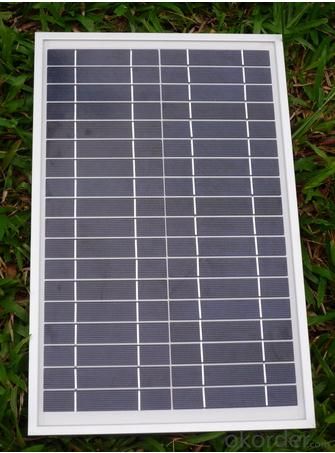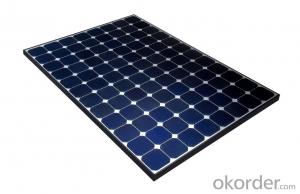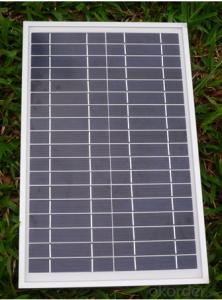110KW CNBM Monocrystalline Silicon Panel for Home Using
- Loading Port:
- Tianjin
- Payment Terms:
- TT OR LC
- Min Order Qty:
- 10 watt
- Supply Capability:
- 1000 watt/month
OKorder Service Pledge
OKorder Financial Service
You Might Also Like
Item specifice
110KW CNBM Monocrystalline Silicon Panel for Home Using
Production description
On 13 April 2006, USA Today reported that there were "some 180,000 families living off-grid, a figure that has jumped 33% a year for a decade," and cited Richard Perez, publisher of Home Power Magazine,[6] as the source.[7] Assuming the same rate of growth, there would be a quarter million off-grid households in the United States by late 2007. Because many Third World citizens have never had the chance to go on the grid, current estimates are that 1.7 billion people live off-grid worldwide.[8] A wave of TV shows and articles came out after the publication of "Off the Grid, Inside the Movement for More Space, Less Government and True Independence in Modern America" by Nick Rosen in 2010.[9]Off-the-grid homes are autonomous; they do not rely on municipal water supply, sewer, natural gas, electrical power grid, or similar utility services. A true off-grid house is able to operate completely independently of all traditional public utility services. The idea has been recently popularized by certain celebrities including Ed Begley, Jr.[1] who stars in Living with Ed[2] television show on the Home & Garden Television (HGTV) network. Actress Daryl Hannahpromotes off-grid living and constructed her home in Colorado according to those principles, as does survival expert and Dual Survival co-star Cody Lundin,[3]who lives in a self-designed, passive solar earth house in the high-desert wilderness of Northern Arizona, collecting rainwater, composting waste, and paying nothing for utilities.[4][5]
The large magnitude of solar energy available makes it a highly appealing source of electricity. The United Nations Development Programme in its 2000 World Energy Assessment found that the annual potential of solar energy was 1,575–49,387 exajoules (EJ). This is several times larger than the total world energy consumption, which was 559.8 EJ in 2012.
Electrical power can be generated on-site with renewable energy sources such as solar (particularly with photovoltaics), wind, micro hydro, geothermal; with agenerator or Micro combined heat and power with adequate fuel reserves. Such a system is called a stand-alone power system. In addition, it is possible to simply eliminate electric power such as in Old Order Amish and Old Order Mennonite communities.
Feature
1.High conversion efficiencies resulting in superior power output performance.
2.Outstanding power output even in low light or high temperature conditions
3.Optimized design for ease of soldering and lamination
Physical characteristic
1. Rigorous quality control meets the highest international standards.
2. High-transmissivity low-iron tempered glass, strong aluminium frame.
3. Using UV-resistant silicon.
4. IS09001/14001/CE/TUV/UL
Packaging
26pcs in one carton 6pallets in 20foot container 14pallets in 40 foot container.
- Q:Can solar energy systems be used in powering religious institutions like churches or temples?
- Yes, solar energy systems can definitely be used to power religious institutions like churches or temples. Solar panels can be installed on the rooftops or surrounding areas of these buildings to harness sunlight and convert it into electricity. This renewable energy source can help reduce the carbon footprint of these institutions, lower their energy costs, and serve as a sustainable and environmentally-friendly solution for their power needs.
- Q:Can solar energy systems be used for water purification?
- Yes, solar energy systems can be used for water purification. Solar-powered systems, such as solar stills or solar water disinfection units, can harness the sun's energy to purify water by removing contaminants and killing harmful microbes. These systems are particularly useful in remote areas where access to clean water is limited but sunlight is abundant. By utilizing solar energy, these systems offer a sustainable and environmentally friendly solution to water purification.
- Q:Are there any health risks associated with solar energy systems?
- No, there are no significant health risks associated with solar energy systems. Solar energy is clean and emits no harmful pollutants, unlike fossil fuels which contribute to air pollution and respiratory problems. However, it is important to follow proper installation and maintenance procedures to ensure safety and prevent accidents.
- Q:Are there any insurance considerations for solar energy systems?
- Yes, there are several insurance considerations for solar energy systems. First and foremost, it is important to ensure that the solar energy system is adequately insured against damage or loss. This typically involves obtaining property insurance coverage that specifically includes the solar panels and related equipment. Additionally, liability insurance is also crucial for solar energy systems. This type of insurance protects against any damages or injuries that may occur as a result of the solar energy system, such as a panel falling and causing property damage or personal injury. Liability coverage should be sufficient to cover potential risks and liabilities associated with the installation, operation, and maintenance of the system. It is also important to consider business interruption insurance. This type of coverage can provide financial protection in the event that the solar energy system becomes damaged or malfunctions, resulting in a loss of power production and revenue. Business interruption insurance can help to cover the costs of repairs, replacement equipment, and any lost income during the downtime. Finally, it is advisable to consult with an insurance professional who specializes in renewable energy systems to ensure that all potential risks and exposures are properly covered. They can assist in identifying any additional insurance considerations specific to the solar energy system and provide guidance on the appropriate types and levels of coverage needed to adequately protect the investment.
- Q:Can a solar energy system be installed in areas with high winds?
- Yes, a solar energy system can be installed in areas with high winds. However, it is crucial to take into account the wind load and design the system accordingly. Solar panels are designed to withstand various weather conditions, including strong winds, but they need to be properly mounted and secured to ensure their stability. Additionally, using aerodynamic mounting systems and tilt mechanisms can help reduce the impact of high winds on the solar panels. It is recommended to consult with a professional installer who can assess the specific wind conditions in the area and provide appropriate solutions to ensure the system's durability and performance.
- Q:Can solar energy systems be used in powering movie theaters or entertainment venues?
- Certainly, movie theaters and entertainment venues can absolutely utilize solar energy systems to provide power. The operation of these venues requires a substantial amount of electricity for their lighting, sound systems, projectors, and other equipment. Solar energy systems have the ability to generate clean and renewable electricity by harnessing the sun's power. By installing solar panels on the roofs or in the surrounding areas of these venues, they can generate a significant amount of electricity to fulfill their energy requirements. Not only can solar energy systems be designed to supply power for the basic infrastructure of movie theaters or entertainment venues, but they can also support additional energy-intensive features such as HVAC systems, concession stands, and even electric vehicle charging stations. By utilizing solar energy, these venues can greatly reduce their dependence on grid electricity, decrease operational expenses, and contribute to a more sustainable and environmentally friendly future. Besides the practical advantages, the installation of solar energy systems in movie theaters or entertainment venues can also serve as a demonstration of environmental responsibility and attract environmentally conscious audiences. Many individuals are becoming increasingly aware of the significance of renewable energy, and by showcasing their commitment to sustainability, these venues can enhance their brand image and appeal to a wider customer base. In conclusion, the utilization of solar energy systems to power movie theaters or entertainment venues is not only technically viable but also financially and environmentally beneficial. By harnessing the sun's power, these venues can diminish their carbon footprint, save on energy costs, and contribute to a greener future for the entertainment industry.
- Q:Can solar energy systems be used for powering electric vehicle charging infrastructure?
- Yes, solar energy systems can definitely be used for powering electric vehicle (EV) charging infrastructure. Solar power is a clean and renewable energy source that can be harnessed through photovoltaic (PV) panels. These panels can be installed on rooftops, carports, or open fields, and they convert sunlight into electricity. The electricity generated by solar panels can be used to directly charge EVs or to power the EV charging infrastructure including charging stations, grid-tied DC fast chargers, or battery storage systems. By using solar power to charge electric vehicles, we can significantly reduce greenhouse gas emissions and dependency on fossil fuels. Solar-powered EV charging infrastructure offers numerous benefits. Firstly, it helps reduce the carbon footprint associated with transportation by using clean energy instead of relying on electricity from the grid, which is often generated from fossil fuel sources. Secondly, it provides an opportunity for decentralized energy production, allowing EV owners to charge their vehicles with renewable energy generated on-site. This reduces strain on the electric grid and promotes energy independence. Furthermore, solar EV charging infrastructure can be combined with energy storage systems such as batteries. This enables the storage of excess solar energy during the day and its utilization for EV charging during the night or when the sun is not shining. Battery storage can also help manage peak demand and ensure a more stable and reliable power supply for the charging infrastructure. The implementation of solar-powered EV charging infrastructure is a growing trend globally. Public and private entities are installing solar panels at charging stations, parking lots, and highways to provide sustainable and economical charging options for electric vehicle owners. Additionally, government incentives and subsidies are often available to encourage the adoption of solar energy and EVs. In conclusion, solar energy systems can be effectively used for powering electric vehicle charging infrastructure. This combination provides a sustainable and clean solution for transportation, reduces carbon emissions, and promotes energy independence.
- Q:Can solar energy systems be used in remote areas without access to the power grid?
- Yes, solar energy systems can certainly be used in remote areas without access to the power grid. In fact, solar power is often the ideal solution for such locations. Solar energy systems consist of solar panels that convert sunlight into electricity, and this electricity can be used to power various appliances and devices. Remote areas that are off-grid typically lack access to traditional sources of electricity, such as power lines. However, solar energy systems provide an independent and sustainable source of power. By harnessing the abundant sunlight available in these areas, solar panels can generate electricity even in the absence of a power grid. Solar energy systems in remote areas can be designed to store excess energy in batteries, ensuring a continuous power supply even during cloudy days or at night. These battery systems allow for the storage of solar-generated electricity, providing a reliable source of power for various needs, such as lighting, communication devices, water pumps, refrigeration, and even powering small businesses. Furthermore, the installation and maintenance of solar energy systems in remote areas are often more cost-effective compared to extending power lines from the grid. Solar panels have become more affordable in recent years, and advancements in technology have increased their efficiency and durability. Additionally, the absence of fuel costs and the minimal need for ongoing maintenance make solar energy systems a sustainable and cost-efficient solution for remote areas. Overall, solar energy systems are an excellent option for powering remote areas without access to the power grid. They provide a sustainable, reliable, and cost-effective source of electricity, enabling the development and improvement of communities in these remote locations.
- Q:Can solar energy systems be used in powering dental clinics or medical clinics?
- Yes, solar energy systems can be used to power dental clinics or medical clinics. Solar panels can be installed on the roofs of these facilities to capture sunlight and convert it into electricity, which can be used to meet their energy needs. This not only helps to reduce their reliance on fossil fuels but also provides a clean and sustainable source of power. Additionally, solar energy systems can be designed to store excess energy for use during non-sunlight hours, ensuring a continuous power supply for critical medical equipment and operations.
- Q:Are there any risks of electrical malfunction or failure with solar energy systems?
- Solar energy systems come with certain risks of electrical malfunction or failure. One of the primary concerns revolves around faulty or damaged electrical connections, which can cause a loss of power generation or even spark electrical fires. Moreover, extreme weather conditions like lightning strikes or strong winds have the potential to harm solar panels or inverters, resulting in either temporary or permanent system failure. Another issue lies in the gradual degradation of solar panels over time, leading to reduced efficiency and eventual replacement. Furthermore, inadequate installation or maintenance practices may contribute to system failure or electrical malfunctions. To mitigate these risks, it is crucial to have solar energy systems installed by qualified professionals and ensure regular inspections and maintenance are conducted.
1. Manufacturer Overview |
|
|---|---|
| Location | |
| Year Established | |
| Annual Output Value | |
| Main Markets | |
| Company Certifications | |
2. Manufacturer Certificates |
|
|---|---|
| a) Certification Name | |
| Range | |
| Reference | |
| Validity Period | |
3. Manufacturer Capability |
|
|---|---|
| a)Trade Capacity | |
| Nearest Port | |
| Export Percentage | |
| No.of Employees in Trade Department | |
| Language Spoken: | |
| b)Factory Information | |
| Factory Size: | |
| No. of Production Lines | |
| Contract Manufacturing | |
| Product Price Range | |
Send your message to us
110KW CNBM Monocrystalline Silicon Panel for Home Using
- Loading Port:
- Tianjin
- Payment Terms:
- TT OR LC
- Min Order Qty:
- 10 watt
- Supply Capability:
- 1000 watt/month
OKorder Service Pledge
OKorder Financial Service
Similar products
New products
Hot products
Related keywords



























